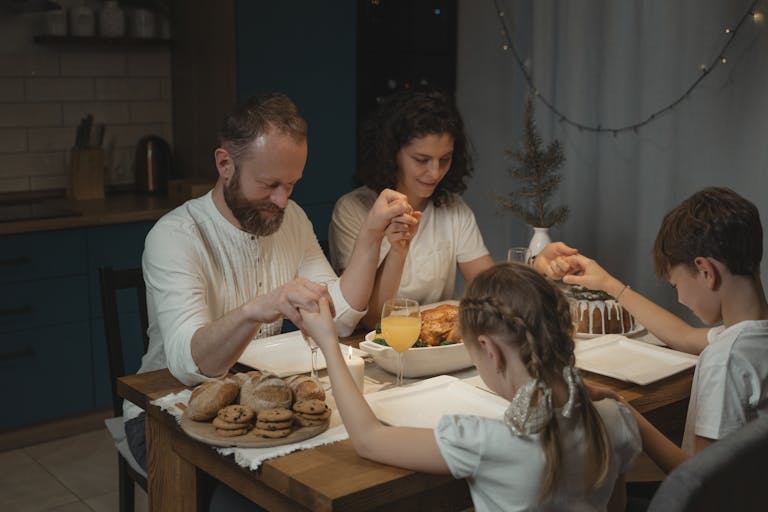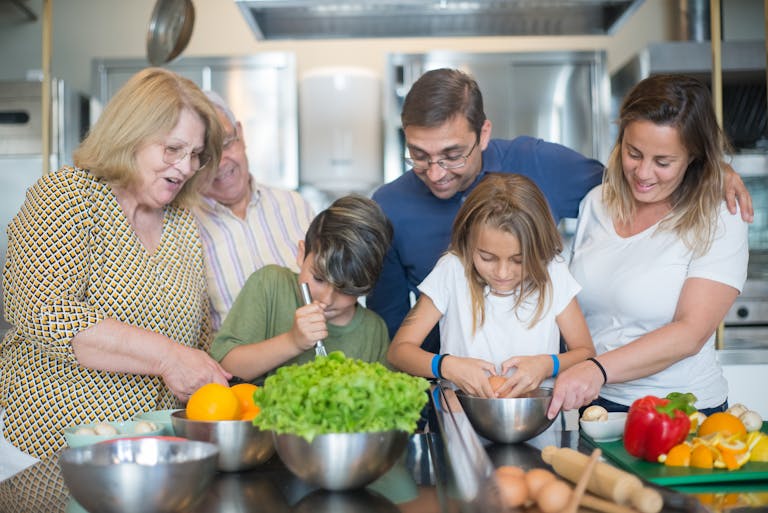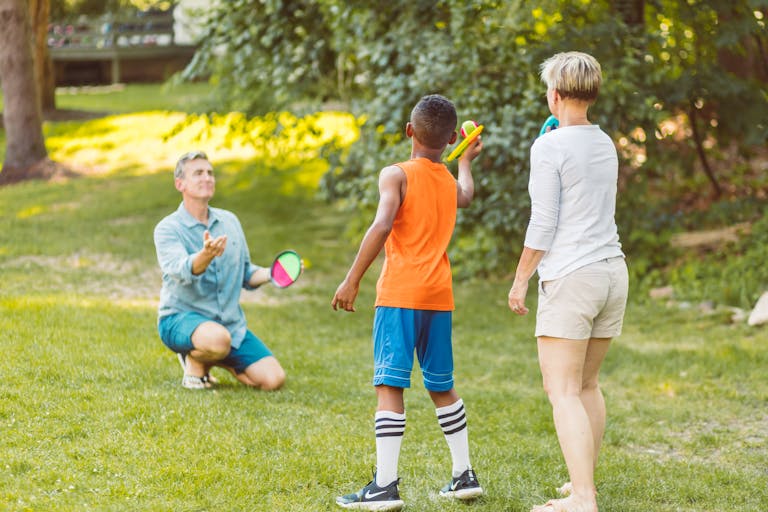Blended families don’t come with a manual but with a lot of love, laughter, and… logistical challenges that make family dinners feel like diplomatic negotiations! If you’ve ever found yourself coordinating schedules with multiple co-parents while trying to remember which kid likes their sandwiches cut diagonally versus straight across, you’re not alone.
They are more common than you think and are a beautiful testament to love and resilience. When families come together after divorce, separation, or loss, they create something entirely new from existing pieces. It’s like building a custom puzzle where all the pieces don’t come from the same box but still fit together perfectly.
It’s important to recognize each family member’s different needs and emotional states, as everyone adjusts at their own pace. Too many changes at once can overwhelm children, so gradual introduction is key.
Blended families create more room for love and support, allowing new relationships to grow. Remarriages bring unique dynamics to blended families; being married or remarried changes family dynamics. Children’s ages can also affect how they adjust to the new family structure, with different ages requiring different approaches. Having more people in the family means more support and opportunities for connection.
Let’s discuss building trust with stepchildren, managing tricky co-parenting relationships, respecting past bonds, and creating new traditions that unite everyone. Building trust is key to a successful blended family.
Blended Family Dynamics
Blending families is a journey that brings together people from different backgrounds, experiences, and traditions to create a new family unit. A blended or stepfamily forms when two people with children from previous relationships decide to build a life together. This new family dynamic can be wonderful and challenging as every family member adjusts to new relationships, routines, and family rules.
Navigating stepfamily life means recognizing that each person brings their history, expectations, and feelings. Children may adjust to changes from previous relationships while parents learn to balance their roles in the new family. Family therapists often help blended families work through these transitions, offering guidance on communicating effectively and creating a healthy family environment.
The key to a successful blended family is understanding that it takes time and effort for everyone involved to feel comfortable and connected. By acknowledging the challenges of blending families and working together to create family rules and routines, family members can build a solid foundation for their new life together.
Building a New Blended Family
When two families form a new blended family, it’s more than just combining households—it merges different parenting styles, family rules, and expectations into a new norm. Every family member, from parents to step-siblings, brings their perspective and experiences, which can be exciting and challenging.
A smart stepfamily approach means taking it one step at a time. Start by getting to know each other without rushing the process. Respect each family member’s feelings and boundaries, and remember that building trust takes time. Step-parenting tips like setting clear limits, establishing consistent discipline, and being open to feedback can help everyone adjust to the new blended family dynamic.
It’s also essential to involve the other parent in discussions about rules and routines so children feel secure and know what to expect in both homes. Encourage open communication and allow everyone to share their thoughts and concerns. By working together, blended families can create a sense of security and belonging and make all family members feel valued and respected as they build new relationships and memories.
Building Trust with Stepchildren
Building a relationship with stepchildren can feel like planting seeds in a garden—it takes time, patience, and a little faith that something beautiful will eventually grow. The keyword here is “eventually”. Don’t expect instant bonding or immediate acceptance, especially if the kids are still adjusting to their parents’ separation or the idea of a new family structure. Stepchildren may have unique challenges accepting a new parent as they navigate family roles and relationship changes.
Start with consistency. Show up when you say you will, follow through on promises, and maintain steady routines. Kids thrive on predictability, and in a world where their family structure has already changed, being someone they can count on makes a big difference. Children may have difficulty accepting a new stepparent after being in a one-parent household, so patience and understanding are key.
Take a genuine interest in their world. Ask about their hobbies, learn their favorite songs, and yes, even knowing those TikTok dances they love is a solid move! The goal isn’t to become their new best friend overnight but to show that you care about what matters to them. Establishing authority and building relationships can be tough for a new parent or stepparent, especially when children adjust to the new family dynamic.
Here’s what not to do: Don’t try to replace their biological parent or jump into disciplinary roles immediately. Respect their relationship with their other parent, even if it’s complicated. Also, don’t try to win them over with gifts or special privileges—kids are smarter than we give them credit for and can spot inauthentic behavior from a mile away. A stepparent can support their stepchild by being patient and understanding and letting trust develop naturally over time.
Most importantly, don’t take rejection personally. Sometimes a child may act out or seem distant, and it’s rarely about you. They’re processing big emotions about family changes, loyalty conflicts, and uncertainty about the future. Give them space to feel their feelings while consistently showing them you’re a safe and supportive presence in their life.
Helping Children Adjust
Adjusting to a new blended family can be a big transition for children and is often filled with mixed emotions. Kids may feel uncertain, anxious, or even sad about the changes in their family life as stepparents and parents. Providing a sense of security and stability while allowing children to express their feelings openly is key.
Patience is key—give children time to process their emotions and adjust to the new family dynamic. Let them know it’s okay to feel a range of emotions and reassure them that their feelings are valid. Step parents can support children by being present, listening without judgment, and showing understanding as they navigate this new chapter.
Family therapists can be a valuable resource, offering guidance and support to help children and parents work through the challenges of blended family life. Creating a safe and supportive environment where children feel heard and respected helps them feel more comfortable and secure in their new family. With time, understanding, and encouragement, children can embrace and find their place in their new blended family.
Managing Co-Parenting Relationships
Co-parenting with an ex can feel like walking a tightrope while juggling flaming torches – it requires balance, focus, and the ability to keep your eye on what matters: the kids. The relationship between co-parents sets the tone for the blended family dynamic, so it’s worth putting in the effort to make it work.
Communication is key, but it doesn’t have to be long, heart-to-heart conversations. Keep conversations child-focused and business-like. Discuss schedules, school events, medical appointments, and essential decisions. Save the emotional processing for your friends, therapist, or journal.
Set clear boundaries about roles and responsibilities. Who pays for what? How are decisions about activities or discipline made? What’s the protocol for emergencies or schedule changes? When setting boundaries, co-parents must consider the needs of their respective children to ensure everyone feels secure and understood. Having these conversations upfront prevents a lot of stress and conflict later.
Here’s a co-parenting reality check: there will be wins and fails. Co-parenting win? Successfully coordinating a birthday party that all adults attend without drama. Co-parenting fails? Getting into a text argument about bedtime snacks while your seven-year-old becomes the mediator. Introducing a new spouse can also change co-parenting dynamics, requiring open communication and flexibility from everyone involved. Learn from the fails and celebrate the wins.
Consider using co-parenting apps like OurFamilyWizard or Cozi to help organize schedules, share important information, and document communication. These tools can reduce the number of direct interactions needed while ensuring everyone stays informed about what’s happening in the kids’ lives.
Remember, respect doesn’t mean you have to be best friends with your ex, but it does mean treating them with basic human decency, especially in front of the children. Maintaining respect between former spouses is crucial for the children’s well-being and helps foster a positive environment. Kids are always watching and learning about relationships from how the adults in their lives interact.
Maintaining a Healthy Marriage
A strong marriage is the foundation of a successful blended family. When couples prioritize their relationship, they set a positive example for all family members and create a stable base for the new family unit. Blended families face unique challenges, such as balancing different parenting styles, managing relationships with stepchildren, and meeting the needs of both their children and their partner.
Open communication is key—talk honestly about your feelings, expectations, and concerns. Work together as a team to navigate parenting decisions and support each other through the ups and downs of stepfamily life. A smart stepmom or stepdad knows that respecting their partner’s feelings and being flexible can go a long way in maintaining harmony.
Remember to make time for each other, even amidst the busy schedules and demands of family life. Whether it’s a regular date night or simply checking in with each other at the end of the day, nurturing your marriage benefits everyone in the blended family. By working together and supporting each other, couples can create a loving, resilient partnership that helps the entire family thrive.
Respecting Past Bonds
One of the greatest gifts you can give children in a blended family is permission to love their whole story—past, present, and future. This means honouring their connection to their biological parents, previous family traditions, and life before the blend happened. Recognise and support your child’s feelings during this transition, as each child’s emotional journey is unique and deserves to be understood.
Give children space to express their feelings about family changes without trying to fix or minimise their emotions. If they’re sad about missing their other parent during your family time, validate that emotion rather than taking it as a personal slight. “It makes sense that you miss Mom when you’re here. That shows how much you love her” is more helpful than “But we’re having fun too, right?”
Encourage children to share stories about their other parent and life outside their home. Ask them about their different families’ traditions or inside jokes. This doesn’t threaten your relationship with them – it strengthens it by showing you accept all parts of who they are.
Keep special traditions alive when possible. If they always made heart-shaped pancakes with their mom on Valentine’s Day, don’t suddenly switch to regular pancakes just because they’re at your house. These small continuities provide comfort during significant changes.
Respecting past bonds also means being gracious about scheduling and flexible when possible. If their biological parent wants to attend a school play, work together to make that happen rather than create territorial battles. Children benefit most when adults in their lives can collaborate rather than compete.
Respecting their roots while providing new ones is the best gift you can give. You’re not trying to erase their past or replace their other parent—you’re adding richness and love to their story.
Building a Support Network
No blended family should feel like they have to go it alone. Building a strong support network is essential for navigating stepfamily life’s unique challenges and joys. Connect with friends, extended family members, and other blended families for understanding, encouragement, and a sense of community.
Stepfamilies can also benefit from the expertise of family therapists who offer practical advice and support tailored to the complexities of blended family dynamics. Sharing with others who have walked a similar path can help family members feel less isolated and more empowered to handle whatever comes their way. A support network gives you more than advice—security, stability, and a reminder you’re not alone on this journey. By reaching out and connecting, blended families can build a strong foundation of support so every family member feels valued, understood, and ready to embrace their new life together.
Creating New Traditions Together
Building new family traditions is where the magic happens in blended families. These shared experiences become the glue that binds everyone together and creates a family identity that belongs to all of you.
Start with simple, low-pressure activities everyone can enjoy. Maybe it’s Taco Tuesday, where everyone builds their taco, a Sunday movie marathon with homemade popcorn flavours, or a weekly family game night where the winner picks next week’s game. Consistency is key – these activities become “your thing” as a family. If only one child is in the blended family, creating new traditions can be especially important to help one child feel included and connected to the new family unit.
Involve everyone in the brainstorming process. Hold a family meeting where each person suggests ideas for new traditions. This way, everyone feels heard and invested in the outcome. You might be surprised by the creative ideas kids come up with!
Don’t be afraid of silly traditions. Some of the most treasured family memories come from the most ridiculous activities. Sunday Sundaes where everyone piles on whatever toppings they want (without questioning anyone’s marshmallow intake!) might become what your kids remember most about their childhood.
Consider seasonal traditions that mark time and create anticipation. Maybe you take a family photo in the same spot every fall, have a summer camping trip to the same lake, or create elaborate Halloween costumes together. These recurring events give children something to look forward to and create shared memories over time.
Holiday traditions deserve special attention in blended families. Since kids might celebrate holidays in multiple homes, consider creating unique ways to mark special occasions that are yours alone. Maybe Christmas Eve is your special time together, or you celebrate “Family Day” on a random date just for your blended crew.
Blended Families by the Numbers
Here are some encouraging stats that show just how normal and beautiful blended families are:
- 16% of children in the US live in blended families
- Over 50% of US families are non-traditional, with blended families making up a big chunk of that
- 75% of children whose parents remarry report feeling positive about their blended family experience within 2 years* Blended families that create new traditions together report higher satisfaction and bonding
- Children in successful blended families often develop better conflict resolution and adaptability skills
Note: Children of different ages may have different experiences and adjustment periods in blended families. Their age can also impact how they develop conflict resolution and adaptability skills as their needs and behaviors change at different stages.
These stats remind us that blended families aren’t just surviving—they’re thriving and creating their own definition of family.
Celebrating Your Beautiful Mosaic
Building a successful blended family isn’t about perfection but persistence, patience, and love. Yes, there will be days when coordinating schedules feels impossible, kids miss their other parent, or old tensions flare up between co-parents. But there will also be magic moments when you realise this patchwork family you’ve created has become stronger and more beautiful than you ever imagined.
Blended families are like mosaics. Each unique piece—a child’s relationship with their biological parent, a new stepparent’s fresh perspective, or a new family tradition—creates something strong, colourful, and beautiful. A new marriage brings opportunities for growth and new beginnings, helping everyone in the blended family adjust and thrive together.
Building trust takes time, managing relationships requires ongoing effort, and creating new bonds while respecting old ones is delicate work. Be patient with yourself and each family member as everyone adjusts to this new normal.
Every blended family’s journey is different, and that’s exactly as it should be. Share your experiences, celebrate your wins (even the small ones!), and don’t hesitate to ask for help when needed. You’re not just blending families—you’re writing a new kind of love story, and that’s pretty cool.
What traditions is your blended family creating? Share your favourite new family activities in the comments—we’d love to celebrate your unique family story and maybe inspire other families just starting their blending journey!





